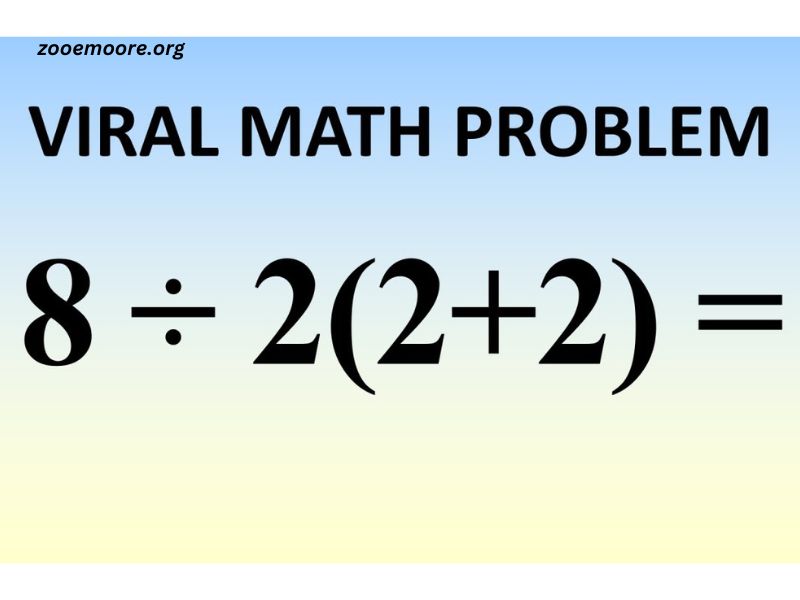The mathematical expression “8/2(2+2)” has sparked widespread debate across the internet and in classrooms. What seems like a simple equation at first glance has ignited confusion and controversy due to the different interpretations of the order of operations. To fully understand this puzzle and the different ways people approach solving it, let’s break it down, step by step, using established mathematical principles. This will also shed light on why this problem has generated such intense discussions in mathematical communities and beyond.
What Is 8/2(2+2)?
At first glance, the expression “8/2(2+2)” appears to be a straightforward arithmetic problem. However, it’s essential to examine the order of operations, also known as PEMDAS (Parentheses, Exponents, Multiplication, Division, Addition, Subtraction), to clarify how this expression should be interpreted.
Let’s break it down:
- 8/2(2+2)
This expression consists of three components:
- 8: A constant number.
- /2: Division by 2.
- (2+2): A group inside parentheses that simplifies to 4.
Thus, we are left with:
- 8/2 * 4
Now, according to the order of operations, multiplication and division are treated with equal precedence and should be performed from left to right. Therefore, the correct way to solve this would be:
- 8/2: Divide 8 by 2, which equals 4.
- 4 * 4: Multiply the result (4) by 4, which equals 16.
Therefore, the solution to the expression 8/2(2+2) is 16.
The Controversy: Different Interpretations
Despite the above solution, there has been significant debate regarding how to interpret the expression. The controversy arises from the way people approach the notation “8/2(2+2).” Some individuals believe that the expression should be interpreted as:
- 8/(2(2+2))
In this case, the parentheses would imply that the division applies to the entire expression in the denominator, not just the number 2. So, the equation would become:
- 8/(2 * 4)
Which simplifies to:
- 8/8 = 1
This interpretation leads to a completely different answer — 1 instead of 16.
Why the Confusion Exists
The confusion stems from the notation itself. When a number is followed directly by parentheses, such as 2(2+2), some interpret it as multiplication, while others view it as part of the overall expression in the denominator. This issue, in part, arises because mathematical notation can sometimes be ambiguous, particularly when parentheses are involved.
The root of the problem lies in the lack of explicit grouping in the original expression. In the case of 8/2(2+2), the lack of clear parentheses around the division and multiplication leads people to take different approaches. While mathematical conventions dictate that division and multiplication should be handled from left to right, the implicit grouping could easily lead someone to assume that the division applies only to the 2 and not to the entire expression in the parentheses.
Additionally, the “slash” symbol (/) for division, when used in tandem with parentheses, adds another layer of uncertainty. In some contexts, people might interpret this as a signal to divide the entire numerator by the denominator in a more traditional fraction-like format. This is why there is so much variance in how people interpret the expression, especially when it’s presented without additional clarification.
The Role of Parentheses in Clarifying Expressions
One of the fundamental lessons from this puzzle is the importance of parentheses in mathematical expressions. Parentheses are used to clarify the order in which operations should be performed, and when used properly, they can eliminate any ambiguity. In this case, if the problem had been written as 8/(2(2+2)), there would have been no debate, as the division would clearly apply to the product of 2 and (2+2).
On the other hand, if the expression were written as (8/2)(2+2), the correct interpretation would be to first divide 8 by 2, and then multiply by 4. This would yield the same result, 16.
The Importance of PEMDAS/BODMAS
Understanding the order of operations is crucial when solving mathematical expressions, especially those involving multiple operations. The order of operations rules, commonly abbreviated as PEMDAS or BODMAS, guide us on how to prioritize operations.
Here’s a quick breakdown of the order of operations:
- P/B: Parentheses first.
- E/O: Exponents (including powers and roots).
- MD: Multiplication and Division (from left to right).
- AS: Addition and Subtraction (from left to right).
In the case of 8/2(2+2), the parentheses take precedence first. This simplifies (2+2) to 4. After this, division and multiplication follow from left to right, according to the rules of PEMDAS/BODMAS.
If someone incorrectly applies PEMDAS by prioritizing multiplication over division, they may incorrectly arrive at a different result. This highlights the critical importance of adhering strictly to the order of operations.
Examples of Similar Ambiguities in Math
The controversy surrounding 8/2(2+2) is not unique. There are many other examples where different interpretations of an expression can lead to multiple answers. Here are a few other ambiguous expressions:
- 3+5×2: Some might argue that multiplication should be performed first, resulting in 3 + 10 = 13, while others may believe addition should come first, yielding 8×2 = 16.
- 4 ÷ 2(2+2): Is this interpreted as 4 ÷ (2(2+2)) or (4 ÷ 2)(2+2)? Each interpretation leads to a different result.
- 5-2+3: Should you subtract first or add? According to PEMDAS, subtraction and addition are on the same level, so this should be solved from left to right, resulting in (5 – 2) + 3 = 6.
These examples reinforce the idea that notation in mathematics is critical for accurate communication. Without the right context or clarity, simple expressions can lead to confusion.
The Educational Impact of the 8/2(2+2) Debate
The 8/2(2+2) puzzle is a fascinating example of how mathematical discussions can extend beyond classrooms into popular culture. It highlights the importance of teaching mathematical conventions, particularly how to interpret and solve expressions with different operations. This debate has also sparked discussions on how to improve mathematical notation to reduce ambiguity and ensure that everyone is on the same page.
In educational settings, this puzzle can serve as a valuable teaching tool. It can help students understand the importance of parentheses, the order of operations, and the nuances of interpreting mathematical expressions correctly. Furthermore, it can encourage critical thinking and problem-solving, as students must decide which interpretation makes the most sense given the mathematical principles they’ve learned.
Conclusion
So, what is the answer to 8/2(2+2)? If we follow the order of operations (PEMDAS/BODMAS), the correct answer is 16. This is because division and multiplication are of equal precedence, and we perform them from left to right, first dividing 8 by 2, then multiplying by 4.
However, the controversy surrounding this expression highlights the importance of clarity in mathematical notation. The ambiguity of “8/2(2+2)” emphasizes how a simple mathematical problem can lead to confusion without clear grouping symbols. To avoid such controversies in the future, it’s crucial to write mathematical expressions in a way that leaves no room for misinterpretation.
In summary, 8/2(2+2) serves as an excellent example of why mathematical notation matters, the importance of following order of operations, and the role that parentheses play in clarifying expressions. Understanding these principles is essential for anyone looking to navigate the world of mathematics without falling into the trap of ambiguous notation.

